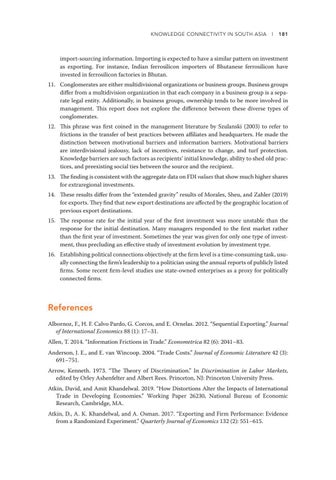KNOWLEDGE CONNECTIVITY IN SOUTH ASIA l 181
import-sourcing information. Importing is expected to have a similar pattern on investment as exporting. For instance, Indian ferrosilicon importers of Bhutanese ferrosilicon have invested in ferrosilicon factories in Bhutan. 11. Conglomerates are either multidivisional organizations or business groups. Business groups differ from a multidivision organization in that each company in a business group is a separate legal entity. Additionally, in business groups, ownership tends to be more involved in management. This report does not explore the difference between these diverse types of conglomerates. 12. This phrase was first coined in the management literature by Szulanski (2003) to refer to frictions in the transfer of best practices between affiliates and headquarters. He made the distinction between motivational barriers and information barriers. Motivational barriers are interdivisional jealousy, lack of incentives, resistance to change, and turf protection. Knowledge barriers are such factors as recipients’ initial knowledge, ability to shed old practices, and preexisting social ties between the source and the recipient. 13. The finding is consistent with the aggregate data on FDI values that show much higher shares for extraregional investments. 14. These results differ from the “extended gravity” results of Morales, Sheu, and Zahler (2019) for exports. They find that new export destinations are affected by the geographic location of previous export destinations. 15. The response rate for the initial year of the first investment was more unstable than the response for the initial destination. Many managers responded to the first market rather than the first year of investment. Sometimes the year was given for only one type of investment, thus precluding an effective study of investment evolution by investment type. 16. Establishing political connections objectively at the firm level is a time-consuming task, usually connecting the firm’s leadership to a politician using the annual reports of publicly listed firms. Some recent firm-level studies use state-owned enterprises as a proxy for politically connected firms.
References Albornoz, F., H. F. Calvo Pardo, G. Corcos, and E. Ornelas. 2012. “Sequential Exporting.” Journal of International Economics 88 (1): 17–31. Allen, T. 2014. “Information Frictions in Trade.” Econometrica 82 (6): 2041–83. Anderson, J. E., and E. van Wincoop. 2004. “Trade Costs.” Journal of Economic Literature 42 (3): 691–751. Arrow, Kenneth. 1973. “The Theory of Discrimination.” In Discrimination in Labor Markets, edited by Orley Ashenfelter and Albert Rees. Princeton, NJ: Princeton University Press. Atkin, David, and Amit Khandelwal. 2019. “How Distortions Alter the Impacts of International Trade in Developing Economies.” Working Paper 26230, National Bureau of Economic Research, Cambridge, MA. Atkin, D., A. K. Khandelwal, and A. Osman. 2017. “Exporting and Firm Performance: Evidence from a Randomized Experiment.” Quarterly Journal of Economics 132 (2): 551–615.

